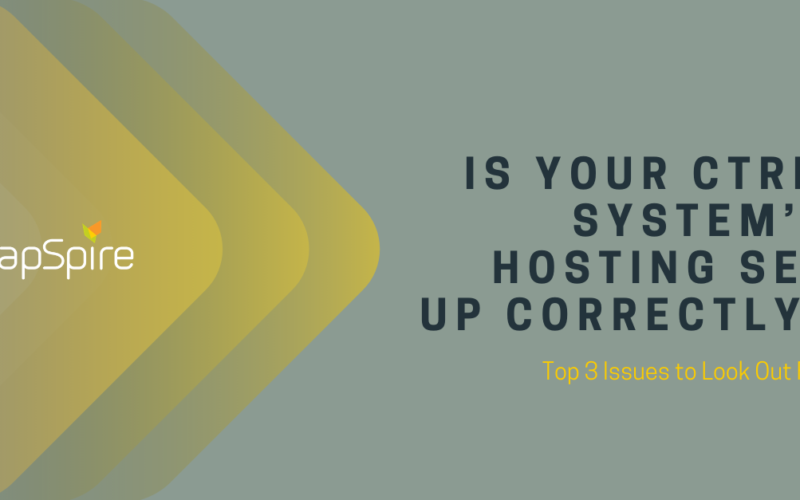Recently, a client of ours that had transitioned a CTRM system to cloud-based hosting noticed some troubling issues related to performance speed and inconsistent monthly subscription fees that caught leadership by surprise. Company stakeholders were mystified by the system’s slowness and unsure of why costs weren’t being managed well.
They asked capSpire to investigate. As it turns out, the culprit was something they hadn’t anticipated: Hosting wasn’t configured correctly.
Whether your company has already moved over to the cloud or you’re considering it, here’s something you need to know: How your system’s hosting is set up matters greatly. It impacts how your system performs, which then affects whether interruptions to business operations happen. It also influences ongoing system costs and ROI.
Here are three issues to look out for in determining whether you could have a hosting problem:
- Your CTRM system is periodically sluggish.
Do you feel as though a function, such as executing a trade or pulling a report, is taking longer than it normally does?
This may be a result of incorrect system configuration.
When you purchase a monthly subscription for cloud hosting, you buy a certain amount of storage. It’s possible that you may not have enough storage and the system is running slowly to compensate. In this case, you’ll need to “right size” your storage to the amount of databases needed so the system runs in a healthy way.
For the client mentioned above, my team reconfigured database storage, set new storage limits, and created an innovative solution for streamlining storage capability. This resulted in the system running more smoothly, and being more responsive to trade and reporting requests.
- Your monthly subscription bills fluctuate.
One of the benefits of moving your system to the cloud is that you now have a monthly subscription fee for hosting the system, as opposed to significant capital expenditures associated with on-premise infrastructure. But if this fee fluctuates wildly from month to month, there’s a problem.
As you add content to your system and ramp up capabilities and storage needs, the cost increases. Back-ups are critical in managing costs because they take content off the production system and store it elsewhere to reduce content needs and free up room in your database.
That’s why you should check to see how your system manages back-ups.
- Are there parameters in place around this process?
- Do backups happen automatically and at regular intervals?
- Does your hosting provider include backup tools? Some offer native tools, some don’t.
For the client referenced earlier, we identified issues with inconsistent and unpredictable monthly billing costs. So my team created a custom back-up tool to streamline the process in alignment with the company’s needs. This resulted in more proactive management of costs and more stability in monthly billing.
- You aren’t proactively monitoring your system for potential issues, and find yourself spending too much time reacting to problems.
Do you find yourself encountering these issues:
- Are servers running out of space?
- Do you have enough storage?
- Are you ever caught off guard by issues with the system?
- Are you noticing that your system is down when you thought it was running?
- Do you experience login issues?
- Can you perform system functions in the manner you expected to when you launched the system?
At the root of these issues is improper configuration.
You need to be able to monitor your CTRM system continuously to understand what’s going on. But since your personnel don’t have the bandwidth to do this 24/7, you should rely on automated tools to do this work for you.
There are all types of automated tools that can conduct proactive surveillance on different aspects of your system. These tools are consistent in their approach and always on, ready to alert you of impending threshold limits.
Otherwise, without these tools to guide you and alert you to issues in advance, you won’t know when thresholds have been reached and you won’t know there’s a major problem until after it’s happened. For example, the result could be disk corruption or the server could crash. By now, you’d have to respond reactively in mitigating the impact on your business—both from an operational and financial standpoint.
capSpire routinely creates automation tools for clients. For example, my team builds tools monitoring these areas:
- Data and server back-ups
- Costs related to hosting provider consumption; specifically, costs associated with storage and system use
- System performance metrics
Once these automations are established, my team layers in the following processes:
- Alerting proactively when established thresholds are compromised
- Communicating with related parties to mitigate or resolve any detected issues
- Providing supplementary resources as needed
And, of course, before ever selecting a hosting provider, it’s crucial to understand the requirements, configurations, and capabilities of each provider under consideration. Evaluate the pros and cons.
To set up a CTRM system correctly, you need to understand the business needs, the system, and the hosting technology at a deep level. System performance and behavior directly correlate to its configuration and deployment. Whether you choose to deploy a system in a single region or across multiple regions will inform system survival in the event of any hosting, network, or power disruptions.
Here are some of our major, general recommendations for clients to “right size” database and application layers:
- Choosing the appropriate relational database management system for your needs (Example: Microsoft SQL Server or Oracle)
- Using HA and cluster replication technology
- Deploying Microsoft IIS farms to host web applications across geographically distributed regions
- Using layers of security both within the host system and within the scope of the application
- Finding the best choice of hosting provider for your needs
- Automating actions by using serverless scripting engine tools, such as AWS Lambda, Google Cloud Functions, and Azure Functions
- Enabling hosting providers’ native tools, such as alerting and monitoring dashboards
- Leveraging load balancing and storage fault tolerance across hosting regions
Why capSpire?
We’re renowned for our extensive knowledge of CTRM systems, which is a niche specialty on its own. But we’re more than just system implementation and upgrades. We also specialize in the energy industry and we know the supplementary technology around CTRM systems, including hosting technology. It takes knowledge of both a CTRM system and the hosting side to get the system to run most effectively.
This puts us in a unique position to advise on solutions to perplexing business and technology challenges.
It’s this comprehensive expertise that helps us maintain system cores so they run correctly in the first place, as well as get to the true reason underlying system issues—and fix the issues in a faster time frame.
Our experience includes taking some of the world’s largest energy organizations to the cloud. This means that we’ve:
- Acquired hosting best practices for both enterprise-level and mid-size companies
- Developed and built out architecture on third-party platforms, as well advising and collaborating on optimal hosting
- Directly hosted some clients on the cloud using architectures we’ve designed
Additionally, capSpire provides automated support services that regularly run system reports identifying issues—but then also fix these issues in tandem. This is a more proactive, cost-effective approach than human support services. Because our support services accomplish more than manual services in the same amount of time, this solution provides clients more bang for their hourly dollars.
Do you want to move your CTRM system into the cloud and want to make sure it’s set up correctly with the hosting provider?
Do the issues that we’ve outlined here sound familiar to you?
Are you leveraging tools in the most optimal way?
Do you want a system health check to identify anything your company could be doing better to reach your goals?
Regardless of your circumstances or challenges, we can help. Email us at info@capspire.com.











